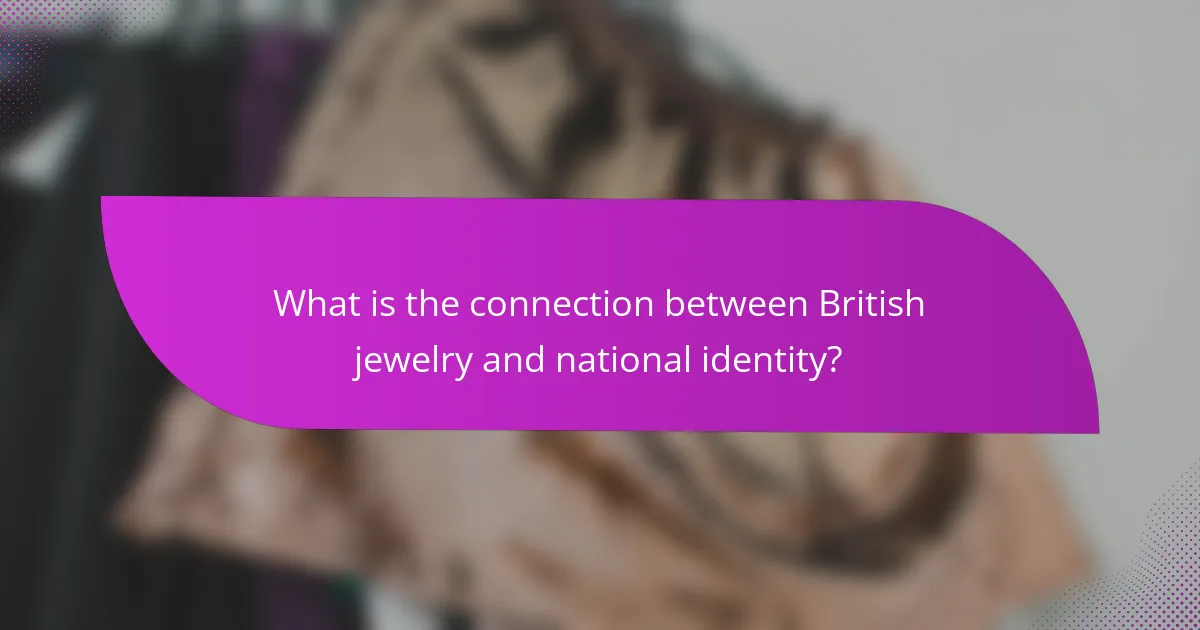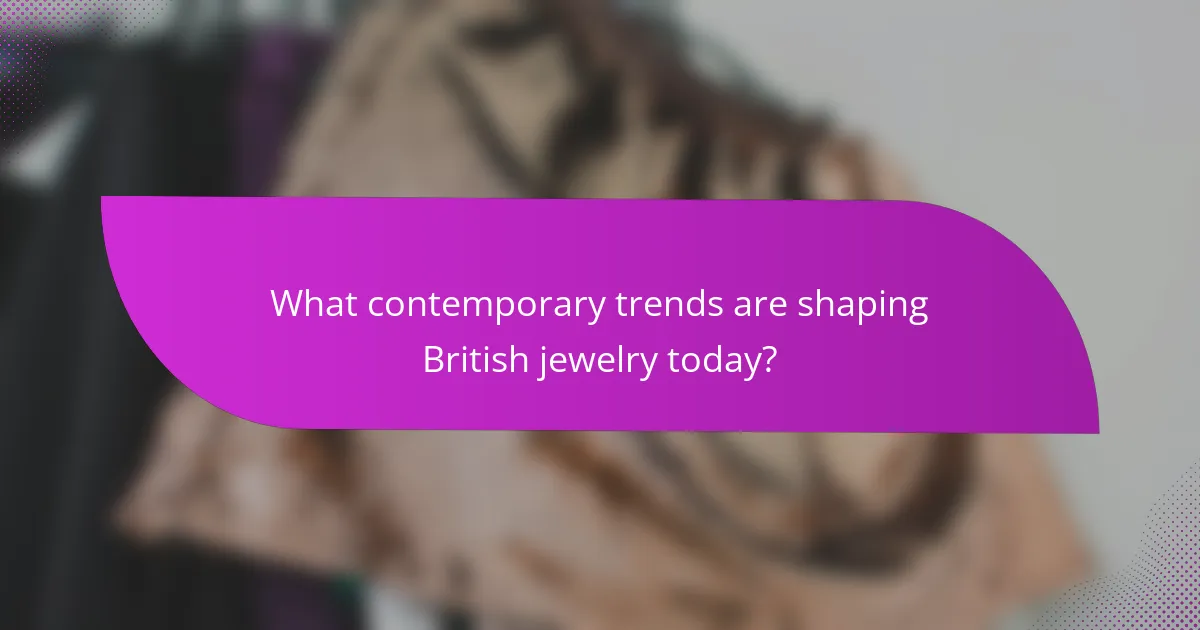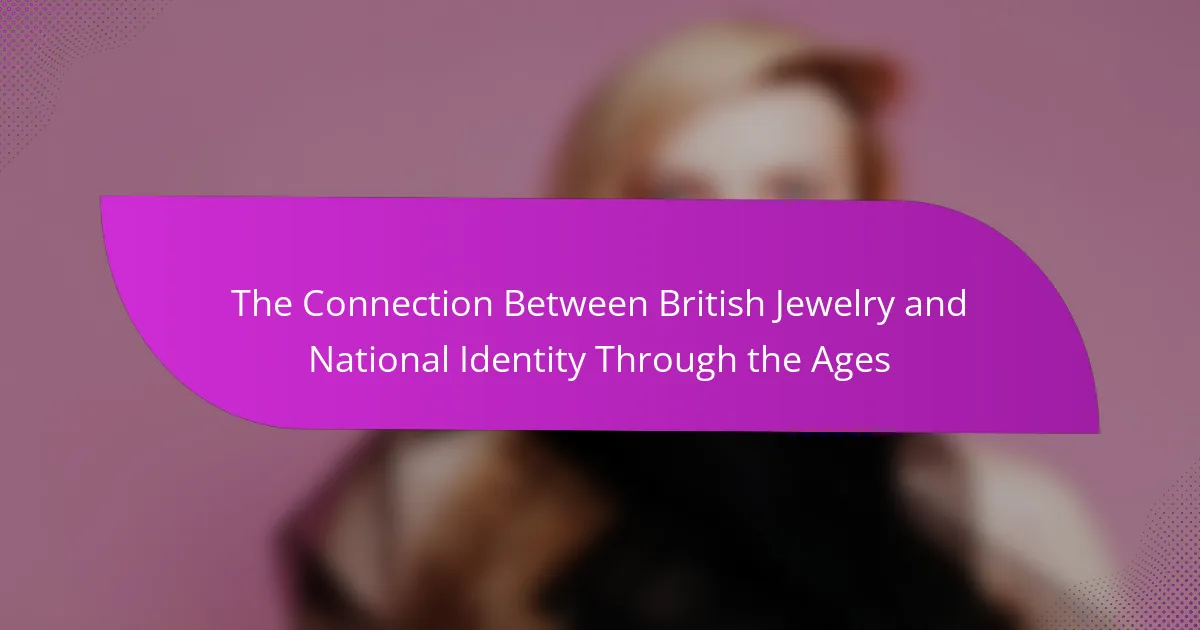British jewelry serves as a significant representation of national identity, reflecting the country’s historical and cultural heritage. This article explores how jewelry has been used in Britain to signify status, heritage, and tradition, with iconic pieces like crowns and tiaras symbolizing royal authority and national pride. Key influences on British jewelry design include historical events, cultural movements, and artisan techniques, particularly during the Victorian era and the Arts and Crafts movement. Contemporary trends such as sustainability, personalization, and the use of innovative materials are shaping the British jewelry market today, showcasing a blend of tradition and modernity. The ongoing evolution of British jewelry illustrates its deep connection to the nation’s identity and craftsmanship.

What is the connection between British jewelry and national identity?
British jewelry reflects national identity through its historical significance and cultural symbolism. Jewelry has been used in Britain to signify status, heritage, and tradition. For centuries, pieces like crowns and tiaras have represented royal authority and national pride. The craftsmanship in British jewelry showcases local materials and artisanal skills. Iconic designs often draw from British history, such as the Tudor rose or Celtic knots. Events like the coronation of monarchs also highlight jewelry’s role in national ceremonies. Furthermore, modern British designers often incorporate contemporary themes, linking tradition with current identity. This evolution of jewelry illustrates the ongoing relationship between craftsmanship and national identity in Britain.
How has British jewelry evolved throughout history?
British jewelry has evolved significantly throughout history, reflecting cultural and societal changes. In ancient times, British jewelry was often made from natural materials like wood and bone. The arrival of the Romans introduced gold and silver craftsmanship, enhancing the complexity of designs. During the Middle Ages, religious motifs dominated jewelry styles, often featuring crosses and saints. The Tudor period saw the rise of elaborate pieces adorned with gemstones, symbolizing wealth and power. The Victorian era introduced sentimental jewelry, including lockets and mourning pieces, reflecting personal emotions. The Arts and Crafts movement emphasized handmade items, focusing on craftsmanship and natural forms. In the 20th century, British jewelry embraced modernism, incorporating innovative materials and designs. Each period’s jewelry not only served as adornment but also as a reflection of national identity and cultural values.
What historical events influenced the design of British jewelry?
The design of British jewelry has been influenced by several historical events. The Roman conquest introduced advanced metalworking techniques and styles. The Norman invasion in 1066 brought new designs and materials from France. The Renaissance period saw the incorporation of intricate designs and gemstones, reflecting European trends. The Industrial Revolution allowed mass production, making jewelry more accessible. The Victorian era emphasized sentimental pieces, influenced by social changes and mourning customs. World War I and II led to resource scarcity, prompting innovative designs from limited materials. Each of these events significantly shaped the evolution of British jewelry design, reflecting cultural and societal shifts.
How did different eras shape the characteristics of British jewelry?
Different eras significantly shaped the characteristics of British jewelry through evolving styles and materials. The Victorian era emphasized intricate designs and sentimental motifs, reflecting personal narratives and societal norms. Art Nouveau introduced organic forms and nature-inspired elements, showcasing craftsmanship and artistic expression. The Edwardian period favored elegance with delicate filigree work and the use of platinum, symbolizing luxury and refinement. The post-war era saw a shift towards modernism, prioritizing minimalism and geometric designs, mirroring societal changes and technological advancements. Each era’s distinct characteristics reveal the cultural, economic, and artistic influences that shaped British jewelry.
What role does symbolism play in British jewelry?
Symbolism plays a significant role in British jewelry, serving as a means of expressing cultural identity and historical narratives. Jewelry often incorporates symbols that reflect national pride and heritage. For instance, motifs like the rose, thistle, and shamrock represent England, Scotland, and Ireland, respectively. These symbols are used to convey allegiance and unity among the nations of the UK.
Additionally, British jewelry has historically included symbols of love and loyalty, such as the Claddagh ring, which signifies friendship, love, and loyalty. The use of symbolism in royal jewelry, like the Crown Jewels, further emphasizes the connection between the monarchy and national identity.
Specific pieces, such as Queen Victoria’s mourning jewelry, illustrate how symbolism can convey personal and collective grief. Overall, symbolism in British jewelry serves to connect individuals to their cultural roots and shared history.
Which symbols are commonly found in British jewelry, and what do they represent?
Common symbols found in British jewelry include the rose, thistle, and shamrock. The rose represents England and signifies love and beauty. The thistle symbolizes Scotland, often associated with bravery and resilience. The shamrock represents Ireland and is linked to luck and faith. Additionally, the crown is a prevalent symbol, representing monarchy and authority. These symbols reflect national identity and cultural heritage in British jewelry. Historical records indicate that these symbols have been used for centuries, reinforcing their significance in representing British unity and diversity.
How do these symbols reflect British cultural values and identity?
British symbols in jewelry reflect cultural values and identity through historical significance and craftsmanship. For example, the crown symbolizes monarchy and tradition, representing the importance of heritage in British culture. The use of national emblems, such as the rose and thistle, highlights regional pride and unity. Additionally, the craftsmanship in British jewelry showcases values of quality and artistry. The enduring popularity of these symbols in modern designs indicates their relevance in contemporary identity. Jewelry pieces often commemorate historical events, reinforcing a collective memory among the British people. Thus, these symbols serve as a tangible connection to the nation’s past and its evolving identity.
How has British jewelry represented social status and class?
British jewelry has historically represented social status and class through its materials, craftsmanship, and design. High-quality materials like gold, diamonds, and pearls were often reserved for the wealthy. The complexity of craftsmanship indicated skill and exclusivity, further elevating the status of the wearer. Jewelry styles often reflected societal norms and class distinctions, such as the use of elaborate designs in aristocratic circles. During the Victorian era, certain motifs and symbols in jewelry conveyed messages about social standing and morality. Additionally, pieces like tiaras and brooches were often associated with nobility and royalty. Historical records show that ownership of specific jewelry types was a marker of wealth and privilege. For example, the Crown Jewels serve as a symbol of royal authority and class. Thus, British jewelry has been a tangible representation of social hierarchy throughout history.
What types of jewelry were associated with different social classes in Britain?
In Britain, jewelry types varied significantly across social classes. The upper class often wore ornate pieces made from precious metals and gemstones. Examples include diamond-encrusted tiaras and gold brooches. The middle class typically favored more modest jewelry. They often chose silver or gold-plated items, such as lockets and simpler rings. The working class primarily wore functional and affordable jewelry. Common items included copper or brass pieces, often handmade. Historical records show that jewelry reflected wealth and social status. For instance, during the Victorian era, elaborate designs were popular among the wealthy. In contrast, simpler styles were adopted by those with less means. This distinction in jewelry illustrates the broader social hierarchy in Britain.
How did the accessibility of jewelry change over time in British society?
The accessibility of jewelry in British society evolved significantly from the medieval period to the present. In the medieval era, jewelry was predominantly a luxury reserved for the wealthy and nobility. Gold and precious stones were expensive and labor-intensive to procure. During the Renaissance, advancements in craftsmanship began to increase jewelry availability. The Industrial Revolution further transformed accessibility by introducing mass production techniques. This allowed for the creation of more affordable pieces, making jewelry accessible to the middle class. By the 20th century, costume jewelry emerged, offering fashionable options at lower prices. Today, a wide variety of jewelry is available to all social classes, reflecting diverse styles and materials. The evolution of jewelry accessibility mirrors broader social changes in British society, highlighting shifts in wealth distribution and consumer culture.

What are the key influences on British jewelry design?
Key influences on British jewelry design include historical events, cultural movements, and artisan techniques. The Victorian era significantly shaped jewelry styles with its emphasis on sentimentality and nature-inspired designs. Art Nouveau introduced organic forms and intricate detailing, reflecting the period’s artistic aspirations. The rise of the Arts and Crafts movement emphasized handcrafted quality and local materials, influencing many British jewelers. Additionally, the influence of global trade brought exotic materials and styles into British designs. The impact of royal patronage, particularly from Queen Victoria and later royals, also played a crucial role in popularizing certain styles. These influences collectively reflect the evolving identity and cultural heritage of Britain.
How have royal influences shaped British jewelry trends?
Royal influences have significantly shaped British jewelry trends throughout history. The British monarchy has often set fashion standards that the public emulates. For instance, Queen Victoria’s love for ornate designs popularized sentimental jewelry in the 19th century. Her choice of mourning jewelry influenced the public’s acceptance of dark gemstones and intricate designs. Additionally, Princess Diana’s engagement ring, featuring a sapphire surrounded by diamonds, sparked a resurgence in colored gemstones. This trend continues today, as seen in modern royal engagements. The royal family’s public appearances often showcase unique pieces that become sought after by the masses. Furthermore, royal endorsements of specific jewelers elevate their status and influence consumer preferences. Thus, royal influences have consistently dictated the evolution of British jewelry trends.
What notable pieces of jewelry have been worn by British royalty?
The notable pieces of jewelry worn by British royalty include the Imperial State Crown, the Koh-i-Noor diamond, and the Cambridge Emeralds. The Imperial State Crown features over 2,868 diamonds and is worn during the State Opening of Parliament. The Koh-i-Noor diamond, originally from India, is part of the Crown Jewels and has a complex history. The Cambridge Emeralds consist of a necklace and tiara gifted to Queen Mary, showcasing exquisite craftsmanship. Other significant pieces include the Lover’s Knot Tiara, worn by Princess Diana, and the Queen Mary Fringe Tiara, which has historical ties to Queen Victoria. Each piece reflects the rich heritage and national identity of the British monarchy.
How have royal engagements and events impacted public perceptions of jewelry?
Royal engagements and events have significantly shaped public perceptions of jewelry. These occasions often showcase exquisite pieces worn by royals, drawing public attention and admiration. For instance, Princess Diana’s engagement ring became a symbol of romantic ideals and influenced trends in bridal jewelry. The media coverage surrounding royal events further amplifies this effect, creating a sense of aspiration among the public.
Jewelry associated with royals often carries historical and cultural significance, enhancing its perceived value. High-profile events, such as weddings and state functions, provide a platform for showcasing craftsmanship and heritage. This visibility leads to increased interest in similar styles within the general populace.
Moreover, royal endorsements can elevate specific brands or designers, making them desirable among consumers. The public often views royal jewelry as a representation of tradition and status, affecting purchasing decisions. Overall, royal engagements and events play a crucial role in shaping trends and perceptions surrounding jewelry in society.
What impact did colonialism have on British jewelry styles?
Colonialism significantly influenced British jewelry styles by introducing exotic materials and designs. British jewelers began incorporating gemstones and motifs from colonized regions. This included diamonds from India and emeralds from Colombia. The influx of these resources led to a diversification of styles. Jewelry became a symbol of wealth and status, reflecting Britain’s global dominance. Colonial influences also inspired new craftsmanship techniques. This resulted in unique pieces that blended British and foreign aesthetics. Ultimately, colonialism shaped British jewelry into a representation of imperial power and cultural exchange.
How did the incorporation of materials from colonies influence British jewelry?
The incorporation of materials from colonies significantly influenced British jewelry by introducing exotic gemstones and metals. These materials included diamonds from India, gold from South Africa, and pearls from the Persian Gulf. The influx of these resources led to a diversification of designs and styles in British jewelry. Jewelers began to create more intricate and ornate pieces, reflecting the wealth and power of the British Empire. This trend was particularly evident during the Victorian era, when colonial materials became symbols of status. The use of these materials also allowed for the expression of national pride. British jewelry became a representation of the empire’s global reach and cultural influences. The combination of local craftsmanship with imported materials resulted in unique pieces that showcased both artistry and imperial ambition.
What cultural exchanges occurred through jewelry during the colonial period?
Cultural exchanges through jewelry during the colonial period included the blending of styles and materials. European colonizers introduced metalworking techniques to indigenous populations. In return, local artisans contributed unique designs and gemstones. These interactions led to hybrid jewelry styles, reflecting both European and native influences. For example, British settlers adopted motifs from African and Asian cultures. Additionally, trade routes facilitated the exchange of precious stones, enhancing jewelry’s aesthetic value. This exchange not only influenced fashion but also shaped social identities. Jewelry became a symbol of status and cultural heritage during this time.

What contemporary trends are shaping British jewelry today?
Contemporary trends shaping British jewelry today include sustainability, personalization, and the use of innovative materials. Sustainability has become a priority, with many brands sourcing ethically and reducing environmental impact. Personalization trends emphasize custom designs and bespoke pieces, allowing consumers to express their individuality. Innovative materials, such as recycled metals and lab-grown gemstones, are increasingly popular. The rise of digital technology has also influenced jewelry design, with 3D printing enabling intricate designs. These trends reflect a broader cultural shift towards responsible consumption and self-expression. The British jewelry market is adapting to these changes, showcasing a blend of tradition and modernity in its offerings.
How are modern designers interpreting traditional British jewelry styles?
Modern designers are reinterpreting traditional British jewelry styles by blending historical elements with contemporary aesthetics. They often incorporate classic motifs such as floral designs, heraldic symbols, and intricate metalwork. These designs reflect Britain’s rich cultural heritage while appealing to modern sensibilities.
Many contemporary pieces utilize innovative materials and techniques, enhancing traditional craftsmanship. For example, the use of sustainable materials resonates with today’s eco-conscious consumers. Designers also experiment with scale and form, creating bold statements that challenge conventional jewelry norms.
This approach not only preserves traditional artistry but also revitalizes it for a new audience. As a result, modern jewelry reflects both a respect for heritage and a forward-thinking attitude. This synthesis of old and new fosters a deeper connection to national identity through evolving expressions of British culture.
What innovative materials and techniques are being used in contemporary jewelry design?
Contemporary jewelry design utilizes innovative materials such as bioresin, 3D-printed metals, and ethically sourced gemstones. Bioresin allows for sustainable creations that mimic traditional materials while being environmentally friendly. 3D printing technology enables intricate designs that were previously impossible to achieve with conventional techniques. Ethically sourced gemstones ensure that the materials used do not contribute to conflict or environmental degradation. Techniques like laser engraving and computer-aided design (CAD) enhance precision and customization in jewelry making. These advancements reflect a shift towards sustainability and individuality in the jewelry industry. The use of these materials and techniques is reshaping the landscape of contemporary jewelry design.
How do modern jewelry brands reflect current British identity and values?
Modern jewelry brands reflect current British identity and values through their designs and materials. They emphasize sustainability, aligning with the growing environmental consciousness in the UK. Many brands incorporate traditional craftsmanship, showcasing a pride in British heritage. The use of local materials supports the economy and highlights a commitment to community. Additionally, contemporary designs often feature inclusive and diverse representations, reflecting modern societal values. For instance, brands like Alex Monroe celebrate British nature and culture, reinforcing a sense of identity. This blend of tradition and innovation resonates with consumers seeking authenticity and meaning in their purchases.
What are the future prospects for British jewelry in relation to national identity?
The future prospects for British jewelry in relation to national identity are likely to evolve significantly. British jewelry will increasingly reflect contemporary cultural narratives. The incorporation of sustainable practices will resonate with national values. Additionally, a resurgence of interest in heritage craftsmanship will strengthen its identity. The influence of global trends will also play a crucial role. British designers may blend traditional techniques with modern aesthetics. Collaborations with local artisans can enhance authenticity. This evolution will create a dynamic representation of British identity in jewelry.
How might changing societal values influence the evolution of British jewelry?
Changing societal values significantly influence the evolution of British jewelry. As societal norms shift, so do the preferences and meanings attached to jewelry. For instance, the rise of sustainability has led to increased demand for ethically sourced materials. Consumers now prioritize transparency regarding the origins of gemstones and metals. This shift encourages jewelers to adopt more eco-friendly practices.
Additionally, changing gender roles impact jewelry design and marketing. There is a growing acceptance of gender-neutral pieces. This evolution reflects broader societal movements toward inclusivity and diversity. Furthermore, the influence of technology has changed how jewelry is produced and sold. Online platforms allow for greater customization and personalization.
Historical events also shape jewelry trends. For example, the Victorian era emphasized mourning jewelry, reflecting societal attitudes toward loss. In contrast, contemporary designs often celebrate individuality and self-expression. Overall, the evolution of British jewelry mirrors the dynamic nature of societal values.
What role will sustainability play in the future of British jewelry design?
Sustainability will play a crucial role in the future of British jewelry design. Designers are increasingly prioritizing eco-friendly materials and ethical sourcing practices. This shift reflects a growing consumer demand for responsible luxury. According to a survey by the Ethical Jewelry Council, 78% of consumers prefer brands that demonstrate sustainability. Additionally, British jewelers are adopting recycled metals and lab-grown gemstones. These practices reduce environmental impact and promote social responsibility. The integration of sustainability is not just a trend; it is becoming a standard in the industry. As regulations tighten and awareness grows, sustainability will shape the identity of British jewelry design.
What tips can consumers follow when choosing British jewelry that reflects national identity?
Choose jewelry that features traditional British symbols. Look for designs incorporating the Union Jack or national flowers like the rose. Consider pieces made from British materials, such as Welsh gold or Scottish silver. Research the history behind the jewelry to understand its cultural significance. Support local artisans who create handcrafted pieces reflecting British heritage. Opt for jewelry that tells a story or has historical relevance. Familiarize yourself with hallmark standards to ensure authenticity. Attend local craft fairs or exhibitions to discover unique British designs.
The main entity of the article is British jewelry, which is explored in relation to its connection with national identity throughout history. The article outlines how British jewelry reflects cultural values, social status, and historical events, demonstrating its evolution from ancient designs to contemporary trends. Key influences on jewelry design, including royal patronage and colonialism, are discussed, along with the symbolism embedded in various pieces. The article also highlights modern trends such as sustainability and personalization, and how these factors shape the future of British jewelry in relation to national identity.
